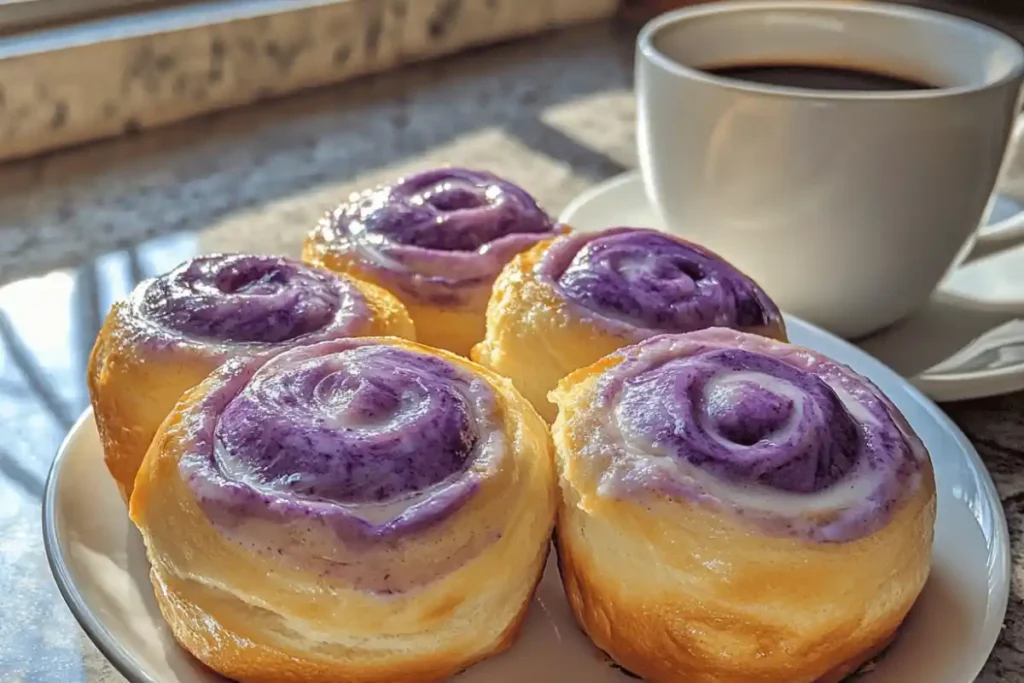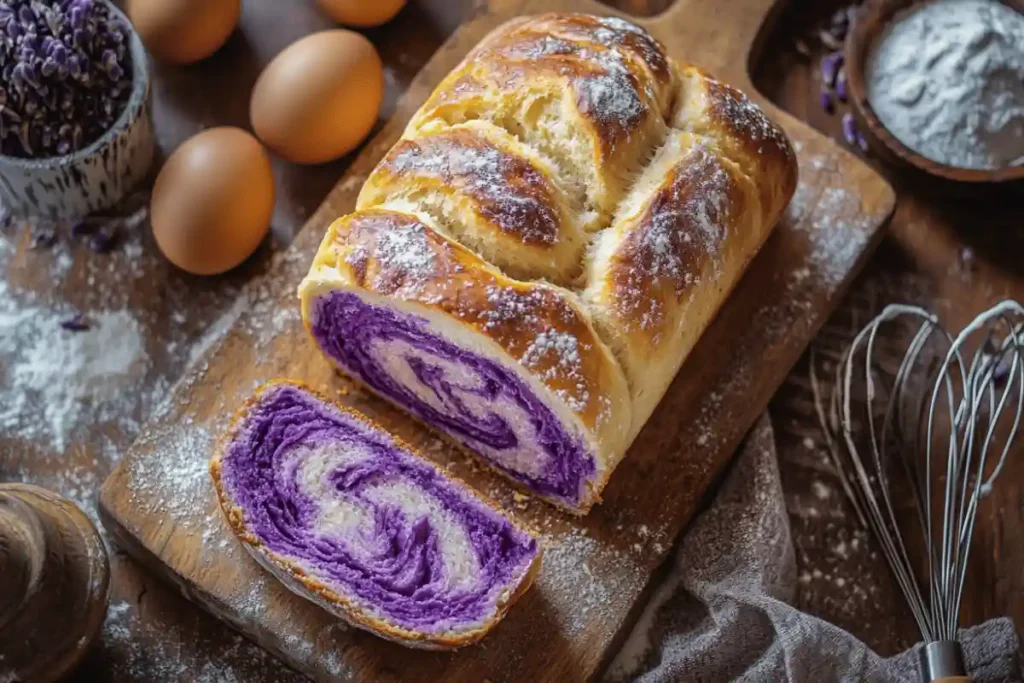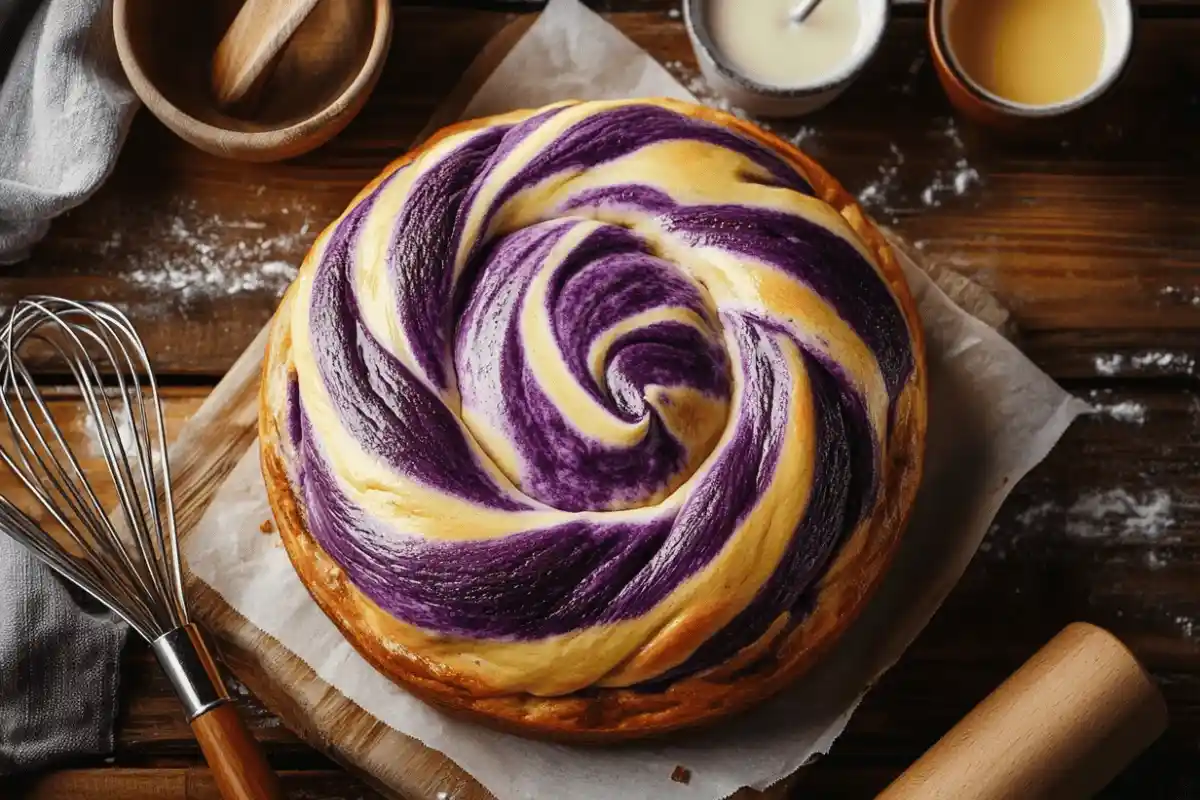Introduction to Ube Milk Bread Recipes
Using ube extract to enhance a milk bread recipe is a delightful twist. This rich, purple ingredient not only adds a vibrant hue but also a unique, sweet, nutty flavor. But can ube extract truly elevate a classic milk bread? The answer lies in understanding how this ingredient complements the bread’s texture and flavor profile.
Adding ube extract to a milk bread recipe is more than just a culinary experiment. Rather, it’s an opportunity to infuse a traditional recipe with a touch of Filipino heritage. In this article, we’ll explore everything you need to know about blending these two delicious components, from understanding their characteristics to perfecting the recipe.
Table of Contents
Exploring Milk Bread

Milk bread, also called Hokkaido milk bread, is a type of soft, fluffy bread with origins in Japan. This bread is celebrated for its pillowy texture, which comes from the incorporation of tangzhong, a water-roux starter. Specifically, the tangzhong method helps retain moisture in the bread, keeping it fresh for longer.
One popular variation of this bread is Ube Milk Bread, which adds a delightful purple hue and a hint of ube’s nutty, vanilla-like flavor. The key to milk bread, including Ube Milk Bread, lies in its ingredients: milk, butter, and sugar combine to create a slightly sweet, melt-in-your-mouth experience. Furthermore, this bread is often used as a base for a variety of recipes, including rolls, loaves, and even sandwiches.
What Makes Milk Bread Special?
Milk bread stands out due to its distinctive texture. Unlike traditional bread, Ube Milk Bread features an elastic crumb structure, which allows it to stay soft and tender for days while showcasing a vibrant purple hue. Moreover, its mild sweetness and rich buttery notes make it an ideal canvas for additional flavors—such as ube.
When exploring whether ube extract can be added to milk bread, it’s essential to maintain this bread’s hallmark qualities. Thus, the addition of ube extract in Ube Milk Bread must enhance rather than overpower the delicate balance of sweetness and fluffiness.
What is Ube?
Ube, also known as purple yam, is a beloved ingredient in Filipino cuisine. With its vibrant purple hue and sweet, nutty flavor, ube has found its way into various desserts and baked goods, becoming a global phenomenon. One modern creation inspired by this ingredient is Ube Milk Bread, which combines the fluffy texture of milk bread with the unique taste and color of ube. But what exactly is ube, and why has it gained so much attention?
Ube is a starchy root vegetable similar to sweet potatoes or taro but distinguished by its natural purple pigment. In Filipino culture, it’s a staple ingredient in traditional desserts like ube halaya (ube jam), ube ice cream, and ube-flavored cakes. Now, modern recipes like Ube Milk Bread have further elevated its popularity, blending its creamy taste with the soft, pillowy texture of milk bread, making it a favorite worldwide.
Ube in Modern Baking
In recent years, ube has transcended its traditional roots, becoming a sought-after flavor in contemporary baking. From Ube Milk Bread to ube donuts and even ube lattes, this versatile ingredient adds a touch of sophistication and creativity to dishes. The introduction of ube extract—a concentrated flavoring—has made it even easier to incorporate this vibrant root into a variety of recipes, including modern baked goods that highlight both its stunning color and unique taste.
What is Ube Extract?
Ube extract is a concentrated liquid derived from ube or created to mimic its flavor. It’s a convenient way to infuse dishes with the distinctive sweet and nutty taste of ube without the need for fresh yams. Typically, the extract is made by blending natural or artificial flavoring with food coloring to achieve the signature purple shade.
Characteristics of Ube Extract
Firstly, ube extract is famous for its deep purple tone, which transforms ordinary baked goods into visually stunning creations. Secondly, it has a sweet, earthy flavor that pairs well with rich, creamy desserts and breads. Furthermore, unlike fresh ube, the extract is ready to use and doesn’t require peeling, boiling, or mashing.
Using ube extract in recipes like milk bread provides not only flavor but also aesthetic appeal. As a result, the vibrant purple swirls or overall coloring can elevate the visual presentation of the bread, making it a show-stopping addition to any meal.
Benefits of Adding Ube Extract to Milk Bread

1) Enhanced Flavor Profile
The naturally sweet and nutty taste of ube complements the subtle sweetness of milk bread, thereby creating a delightful balance. The richness of the extract blends seamlessly with the buttery and milky notes of the bread.
2) Visual Appeal
The deep purple hue of ube extract turns ordinary milk bread into an eye-catching treat. Whether you swirl it into the dough or color the entire loaf, it adds a playful, artistic touch.
3) Cultural Fusion
Incorporating ube extract into milk bread is a nod to the fusion of Japanese and Filipino culinary traditions. Consequently, this combination highlights the versatility of both ingredients and celebrates the creativity of modern baking.
4) Versatility in Pairings
Ube-flavored milk bread pairs wonderfully with a variety of spreads, from cream cheese to coconut jam. Moreover, its unique taste also makes it a standalone dessert when lightly toasted and topped with butter.
How to Incorporate Ube Extract into Milk Bread
Adding ube extract to your milk bread recipe requires careful consideration of flavor balance, texture, and technique. The goal, ultimately, is to preserve the hallmark fluffiness of milk bread while transforming it into Ube Milk Bread, a visually stunning and flavorful variation. By incorporating ube extract thoughtfully, you can enhance the bread’s taste and appearance while ensuring the soft, pillowy texture that milk bread is known for remains intact.
Key Ingredients for Ube Milk Bread
When adapting a milk bread recipe to include ube extract, you’ll need to adjust the ingredients slightly. Here’s a list of the key components:
- Flour: Use bread flour for the ideal structure and chewiness.
- Milk: Whole milk is best for achieving a soft and tender crumb.
- Butter: Provides richness and moisture.
- Sugar: Enhances the sweetness and complements the ube flavor.
- Eggs: Aid in structure and give the bread its characteristic softness.
- Tangzhong: A water-roux paste made by cooking flour and water (or milk) together, essential for retaining moisture.
- Ube Extract: Adds the vibrant purple color and signature flavor. Start with small amounts and adjust based on your desired intensity.
Adjusting the Recipe for Flavor Balance
When adding ube extract, it’s important not to overwhelm the natural flavors of the milk bread. Therefore, follow these tips to achieve a harmonious blend:
- Start Small: Use about 1–2 teaspoons of ube extract for a subtle flavor and color. You can increase the amount if a bolder taste or deeper color is desired.
- Combine with Vanilla: A touch of vanilla extract can enhance the flavor complexity without competing with the ube.
- Watch for Moisture: Ube extract can slightly alter the dough’s hydration levels, so adjust the liquid ingredients as needed to maintain the proper dough consistency.
- Incorporate Evenly: For a uniform color and flavor, mix the ube extract into the wet ingredients before combining with the dry ingredients. Alternatively, swirl it into the dough for a marbled effect.
Step-by-Step Process for Ube Milk Bread

1) Prepare the Tangzhong
Combine 1/4 cup of bread flour with 1/2 cup of water or milk in a small saucepan. Cook over low heat, stirring constantly, until a thick paste forms. Let it cool.
2) Mix the Dough
In a large bowl, combine bread flour, sugar, salt, and instant yeast. In a separate bowl, whisk together the tangzhong, milk, eggs, and butter. Add ube extract to the wet mixture. Gradually combine the wet and dry ingredients to form a soft dough.
3) Knead and Rest
Knead the dough until smooth and elastic, either by hand or using a stand mixer with a dough hook. Let it rest in a warm place until it doubles in size.
4) Shape and Swirl
Roll out the dough and spread a bit more ube extract over the surface for a marbled effect. Roll it back into a loaf shape or divide it into individual rolls.
5) Final Proofing
Let the shaped dough rise again until puffy. This second proofing ensures a light and airy texture.
6) Bake to Perfection
Bake at 350°F (175°C) for 25–30 minutes or until golden brown. Brush the top with melted butter for a glossy finish.
Troubleshooting Milk Bread Recipes
Even the most experienced bakers can encounter challenges when making milk bread. Adding ube extract introduces another layer of complexity, so it’s important to know how to address common issues to achieve the perfect loaf.
FAQs about Ube Milk Bread
In this section, we address common questions about milk bread, ube extract, and their combination. These answers will provide clarity and guidance for bakers of all skill levels.
Why is my milk bread not fluffy?
Milk bread may lack fluffiness for several reasons:
- Underproofing or Overproofing: The dough must rise just enough during proofing stages. Underproofed dough doesn’t trap enough air, while overproofed dough collapses, creating a dense texture.
- Improper Kneading: Kneading develops the gluten structure needed for elasticity and fluffiness. Ensure the dough is smooth and passes the “windowpane test.”
- Incorrect Measurements: Too much flour or not enough liquid can lead to dry dough, which won’t rise properly. Use precise measurements for the best results.
What is the difference between ube extract and powder?
- Ube Extract: A liquid flavoring and coloring agent, ideal for recipes requiring an even distribution of flavor and color, such as milk bread or cakes.
- Ube Powder: Made from dried, ground purple yams, it must be rehydrated and is better for recipes where texture and natural flavor are key, like halaya or fillings.
What is ube bread made of?
Ube bread typically consists of soft, enriched bread dough flavored or filled with ube. Key components include:
- Bread dough made with flour, milk, eggs, butter, and sugar.
- Ube extract for flavor and color.
- Optional fillings like ube halaya (purple yam jam) for added richness.
Can I use ube extract instead of vanilla extract?
Yes, you can substitute ube extract for vanilla extract in recipes where a bold, sweet, and nutty flavor is desired. However, keep in mind that ube extract will also add color, which may affect the appearance of your dish.
Is ube extract healthy?
Ube extract can be a healthy choice when made from natural ingredients. It contains no significant calories or sugars and adds flavor without altering the nutritional profile of a dish. Opt for extracts with natural ube essence for added antioxidants and nutrients.
What is ube used for in baking?
Ube is used in various baked goods to add flavor, color, and cultural flair. Popular uses include:
- Cakes, cupcakes, and cheesecakes.
- Bread rolls and buns.
- Cookies and brownies.
- Pancakes and waffles.
Conclusion: The Perfect Blend of Ube Milk Bread
In conclusion, combining ube milk bread offers an exciting way to elevate a traditional recipe. The sweet, nutty flavor of ube complements the rich, buttery texture of milk bread, while its vibrant purple hue transforms it into an eye-catching treat. Whether you’re experimenting with a new twist on a classic loaf or introducing Filipino-inspired flavors to your baking, ube milk bread is a delicious and versatile choice.
By following this guide and troubleshooting common issues, you can master the art of incorporating ube extract into your milk bread recipe. The end result is Ube Milk Bread—a fluffy, flavorful loaf that’s as visually stunning as it is delicious to eat. With its vibrant purple hue and unique taste, this bread is sure to impress both in appearance and flavor.
Print
Ube Milk Bread: Soft & Fluffy
- Total Time: 2 hours 30 minutes
- Yield: 1 loaf (10 slices) 1x
Description
This Soft & Fluffy Ube Milk Bread recipe blends the pillowy texture of Japanese milk bread with the nutty, sweet flavor of ube. Infused with vibrant purple color and rich aroma, this loaf is perfect for breakfast, snacks, or a colorful twist on sandwiches and desserts.
Ingredients
-
3 cups bread flour
-
2 ½ tbsp sugar
-
1 tsp salt
-
2 tsp instant yeast
-
1 egg
-
½ cup whole milk (warm)
-
½ cup heavy cream or warm water
-
¼ cup unsalted butter (softened)
-
2 tsp ube extract
-
1 tsp vanilla extract (optional)
-
Tangzhong:
-
3 tbsp bread flour
-
¼ cup milk
-
¼ cup water
-
Instructions
1 Make the Tangzhong:
In a small saucepan, whisk together 3 tbsp bread flour, ¼ cup water, and ¼ cup milk. Cook over low heat until a thick paste forms. Let it cool.
2. Mix the Dough:
In a mixing bowl, combine flour, sugar, salt, and yeast. In a separate bowl, mix warm milk, heavy cream, egg, ube extract, vanilla, and the cooled tangzhong. Gradually add wet mixture to the dry ingredients and knead until it forms a dough.
3. Knead with Butter:
Add softened butter and knead until dough is soft, elastic, and passes the windowpane test. This may take 10–15 minutes by hand or 8 minutes with a stand mixer.
4. First Rise:
Cover dough and let rise in a warm spot for 1–1.5 hours until doubled in size.
5. Shape the Dough:
Punch down, roll into a log or divide into portions. Optionally, swirl in extra ube extract or halaya for marbled bread.
6. Second Rise:
Place into a greased loaf pan. Let rise again for 30–45 minutes until puffy.
7. Bake:
Preheat oven to 350°F (175°C). Bake for 25–30 minutes or until golden. Optional: Brush with butter right out of the oven.
8. Cool & Serve:
Let cool before slicing. Enjoy plain or with butter, cream cheese, or coconut jam.
Notes
Notes:
-
Use ube halaya for an added twist in the center.
-
Tangzhong keeps the bread moist and fluffy for days.
-
Add more extract for a bolder color or flavor.
- Prep Time: 20 minutes
- Cook Time: 30 minutes
- Category: Bread
- Method: Baking
- Cuisine: Asian, Filipino-Japanese Fusion
Nutrition
- Serving Size: Per Slice ~60g
- Calories: 210 kcal
- Sugar: 6 g
- Sodium: 180 mg
- Fat: 7 g
- Saturated Fat: 4 g
- Unsaturated Fat: 2.5 g
- Carbohydrates: 31 g
- Fiber: 1 g
- Protein: 6 g
- Cholesterol: 35 mg
Keywords: Ube bread, milk bread, Japanese milk bread, purple yam bread, soft sweet bread
